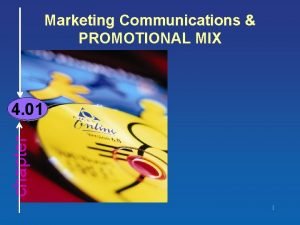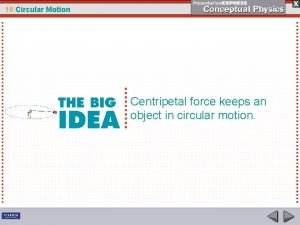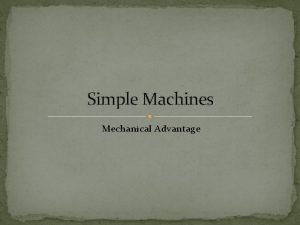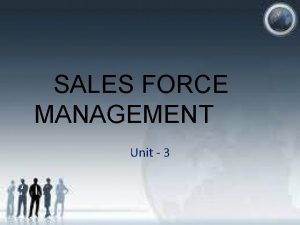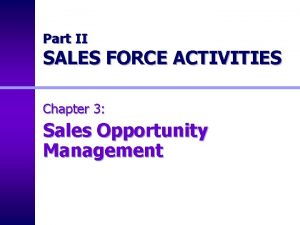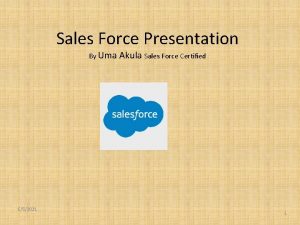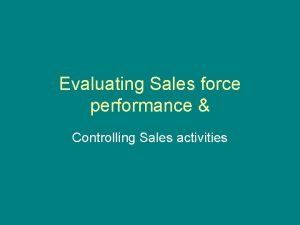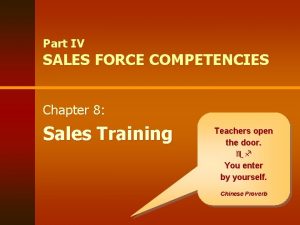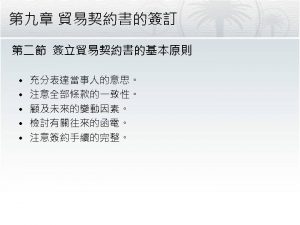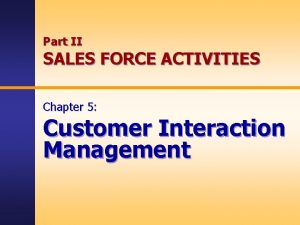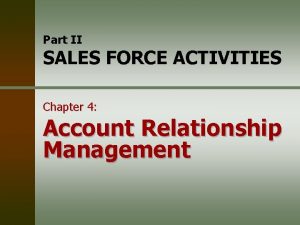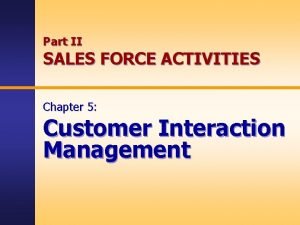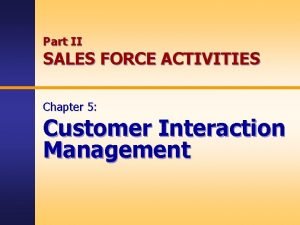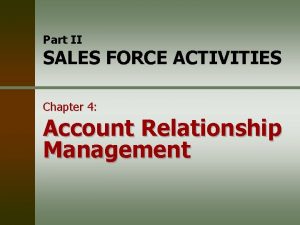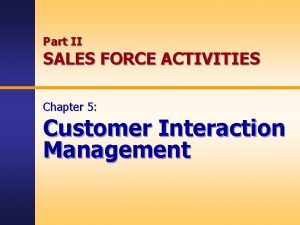Part II SALES FORCE ACTIVITIES Chapter 3 Sales




























- Slides: 28

Part II SALES FORCE ACTIVITIES Chapter 3: Sales Opportunity in Management

Sales Opportunity Management Generating New Accounts Managing Existing Accounts Sales Versus Profits Personal Time Management

Generating New Accounts

What Creates Satisfied Customers? Mergers and Acquisitions 10% Introducing New Products 42% 15% Acquiring New Customers 42% Increasing Business with Existing Customers

Prospect Profile Disposable Medical Supply Distributor n Multiple-practice physician office n Internal medicine, family practice n Suburban location n New practice -- less than 5 years n Good credit history n Currently purchases from a full-service distributor

Siebel Systems, Inc. : Opportunity Assessment Is There an Opportunity? 1 Customer’s Application or Project 2 Customer’s Business Profile 3 Customer’s Financial Condition 4 Access to Funds 5 Compelling Event

Developing a Prospect List 1. Direct Inquiry Advertising Direct Mail Trade publications Trade shows 2. Directories – Thomas Register 3. Referrals 4. Cold Canvassing

Qualifying Prospects 1. Needs for your products/services 2. Authority to make purchase 3. Credit rating & ability to pay 4. Rating scale applied to characteristics by each salesperson

Siebel Systems, Inc. : Assessing the Opportunity Is There an Opportunity? Can We Compete? 1 Customer’s Application or Project 6 Formal Decision Criteria 2 Customer’s Business Profile 7 Solution Fit 3 Customer’s Financial Condition 8 Sales Resource Requirements 4 Access to Funds 9 Current Relationship 5 Compelling Event 10 Can We Win? Unique Business Value Is it Worth Winning? 11 Inside Support 16 Short-Term Revenue 12 Executive Credibility 17 Future Revenue 13 Cultural Compatibility 18 Profitability 14 Informal Decision Criteria 19 Degree of Risk 15 Political Alignment 20 Strategic Value

Managing Existing Accounts Is the account too small?

Table 3 -1 Computing the Cost per Call for an Industrial Products Salesperson Compensation Salary, commissions, and bonus Fringe benefits (hospital, life insurance, social security) $69, 035 $10, 985 $80, 020 Direct Selling Expenses Automobile 8, 000 Lodging and meals 6, 250 Entertainment 3, 250 Communications 4, 500 Samples, promotional material 1, 750 Miscellaneous 1, 700 Total Direct Expenses 25, 450 $105, 470 Calls Per Year Total available days 260 days Less: Vacation 10 days Holidays 10 days Sickness 5 days Meetings 18 days Training 12 days Net Selling Days Average calls per day Total Calls per Year (205 X 3) Average Cost per Call ($105, 470/615) 55 days 205 days 3 calls 615 Calls $171. 50

Sales Opportunity Management Key to Productivity Breakeven Sales Volume (Cost per Call) x (Number of Calls to Close) Sales Calls as a % of Sales

Table 3 -2 Selected Statistics on Cost per Call and Number of Calls Needed to Close a Sales Costs as a Percentage of Total Sales $ 46. 00 4. 6 10. 3% Chemicals 165. 80 2. 8 3. 4 Construction 111. 20 2. 8 7. 2 Electronics 133. 30 3. 9 12. 6 Food Products 131. 60 4. 8 2. 7 Instruments 226. 00 5. 3 14. 8 Machinery 68. 50 3. 0 11. 3 Office Equipment 25. 00 3. 7 2. 4 Printing/Publishing 70. 10 4. 5 22. 2 248. 20 4. 7 3. 6 Industry Business Services Rubber/Plastic Cost per Call

Sales Opportunity Management Selected Break-Even Results Industry Business Services Chemicals Construction Electronics Food Products Instruments Machinery Office Equipment Printing/Publishing Rubber/Plastics Breakeven 1, 096. 37 15, 474. 67 9, 730. 00 433. 25 6, 580. 00 11, 629. 13 1, 580. 77 616. 67 3, 811. 61 41, 662. 14

Now what? Setting Priorities?

Methods for Setting Account Priorities n Single-Factor Model n Portfolio Models n Decision Models n Sales Process Models

ABC Account Classification (Single Factor Model) # of Accounts (1) Total Accounts (2) Sales (000) (3) Total Sales (4) Total Calls per Classif. (5) A 21 15% $910 65% 105 $8667 B 28 20% $280 20% 140 $2000 C 91 65% $210 15% 455 $462 700 $2000 (Avg. ) Account Classif. Totals 140 100% $1400 100% Sales ($) per Call (6)

Portfolio Model Competitive Position High Account Opportunity Strong Weak Core Accounts Growth Accounts n Accounts are Very Attractive n Invest Heavily in Selling Resources Drag Accounts Low n. Accounts are Potentially Attractive n. May Want to Invest Heavily Problem Accounts n Accounts are moderately n. Accounts are Very Attractive Unattractive n Invest to maintain current n. Minimal Investment of competitive position Selling Resources

Customer Break-Even Analysis (Decision Models) Average Sales Volume Per Month $9, 784 $8, 153 C $6, 522 $4, 891 $3, 261 A $1, 630 B 1 2 3 4 5 6 Number of Sales Calls Per Month

How Dell Achieves Selling Efficiencies (Example of Sales Process Model) Traditional Model 100, 000 Catalog Drops Internet Model 100, 000 Website Visits 5, 000 Calls 10, 000 Calls 2, 000 Orders 500 E-Orders 1, 750 Orders

Big Difference?

When Systematic Biases Are Likely to Exist Source of Bias Salespeople Who… Are More Likely To Customer Have low-sales potential, demanding customers Spend too much time with them. Have customers with high service needs or needs that the salesperson can’t meet on his or her own Focus on customers whose needs they can easily meet on their own. Have territories with too many high-sales potential accounts Have low penetration or share as a result of poor coverage. Have little information about the potential of different accounts Spend their effort where the current sales are highest. Have very little cash compensation at risk in the incentive plan Expend too little energy customizing sales actions for individual customers. Company

When Systematic Biases Are Likely to Exist (cont. ) Source of Bias Salespeople Who… Are More Likely To Sales Manager Are managed by the number of calls they make Spend too much time with friendly customers irrespective of potential. Are left alone to decide what to do Have high variability in the quality of precision selling Have difficulty handling rejection and customer objections Shy away from difficult accounts. Are making good progress toward making quota Seek the high-probability, low volume account. Have made quota relatively early in the period Seek the low-probability, high volume account. Salesperson

Time Allocation

Time Allocation n As a salesperson for Strength Footwear, Inc. , you have been very successful. n Your commissions are well over $70, 000 a year. Demand for your product line is very strong, but so is the demand on your time. n You work your territory 220 days a year and can make 4 calls a day. The maximum number of times you need to see any account is every other week, but you need to call on each account at least once a quarter. n To help you allocate your time according to sales results, you have gathered the following information on customer sales:

Time Allocation: Customer Sales Strength Footwear, Inc. Accounts Top 10 Sales Last Year $150, 000 Next 10 best 56, 250 Next 10 best 55, 500 Next 20 best 37, 500 Next 20 best 18, 750 Last 20 15, 000 $370, 000 ü Develop and justify a call schedule for allocating time across the 110 customers in your territory. ü What additional information should you consider in allocating your time?

Time Allocation Analysis Number of Accounts Total Sales Volume 10 $150, 000 10 Percent of Sales Percent of Account Sales per Account 40. 5% 9% 56, 250 15. 2 9 5, 625 10 55, 500 15. 0 9 5, 550 20 37, 500 10. 1 18 1, 875 20 37, 000 10. 0 18 1, 850 20 18, 750 5. 1 18 938 20 15, 000 4. 1 18 750 110 Accounts $370, 000 Call Pattern 100. 0% Total Number of Calls 99% Percent Of Calls $15, 000 $ 3, 364 Sales Per Call Top 10 Every other week 260 29. 6% Next 10 Once a month 120 13. 6 468. 75 Next 10 Once a month 120 23. 6 462. 50 Next 20 About every 2 mos. 110 12. 5 340. 91 Next 20 About every 2 mos. 110 12. 5 336. 36 Next 20 Once a quarter 80 9. 1 234. 38 Last 20 Once a quarter 80 9. 1 187. 50 880 100. 0% $576. 92 $420. 45

Time Management Importance High Low High Emergencies Time Wasters Low Personal Growth Recreation Urgency
 Sales organization structure
Sales organization structure Incremental method of sales force example
Incremental method of sales force example Operating activities vs investing activities
Operating activities vs investing activities Indoor and outdoor sport
Indoor and outdoor sport Support activities and primary activities
Support activities and primary activities Primary activities and tertiary activities
Primary activities and tertiary activities Ielts speaking part 1 water sports
Ielts speaking part 1 water sports 4 types of promotion mix
4 types of promotion mix Which force is a noncontact force?
Which force is a noncontact force? Vt=2pir/t
Vt=2pir/t Long range force
Long range force What force provides centripetal force
What force provides centripetal force Advantage
Advantage Force what is force
Force what is force Centrifugal force definition geography
Centrifugal force definition geography Non contact force
Non contact force Is electric potential conservative
Is electric potential conservative Centripetal force and gravitational force
Centripetal force and gravitational force Hooke's law vector form
Hooke's law vector form Draw the shear and moment diagrams
Draw the shear and moment diagrams Part whole model subtraction
Part whole model subtraction Part to part ratio definition
Part to part ratio definition Brainpop ratios
Brainpop ratios What is technical description
What is technical description Parts of the under bar
Parts of the under bar The part of a shadow surrounding the darkest part
The part of a shadow surrounding the darkest part 미니탭 gage r&r 해석
미니탭 gage r&r 해석 Sales force management definition
Sales force management definition Apa itu sales force automation
Apa itu sales force automation







